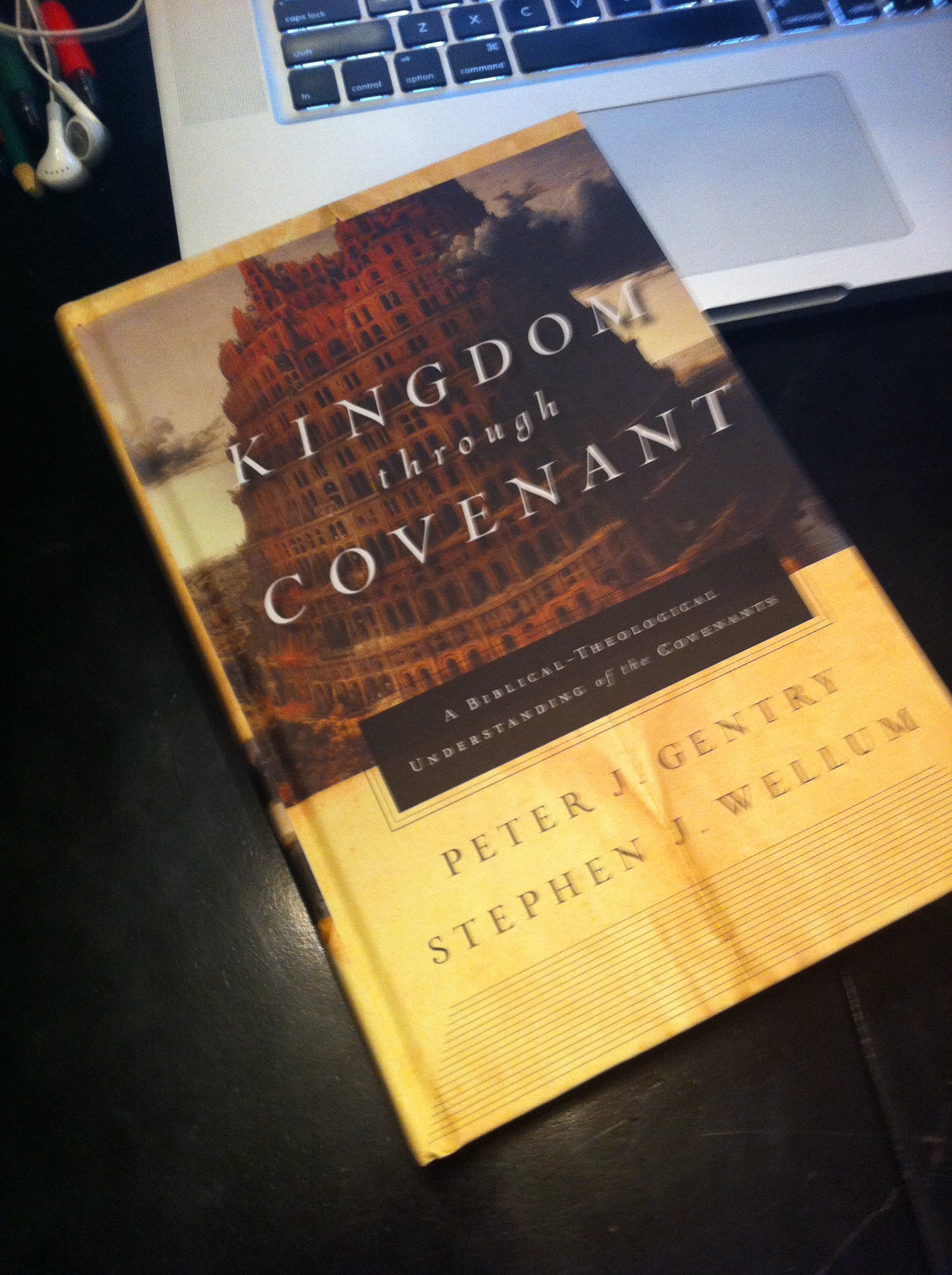This review was originally posted at TGC Reviews
—-
Graeme Goldsworthy, Christ-Centered Biblical Theology: Hermeneutical Foundations and Principles. Downers Grove: InterVarsity, 2012. 251pp. $20.00, paper.
Let me begin by saying what Graeme Goldsworthy’s Christ-Centered Biblical Theology: Hermeneutical Foundations and Principles is not. This book is not a sustained argument that Christ is the center of biblical theology, though that view is repeatedly asserted.[1] Nor is this book an exposition of a selection of biblical themes, a book by book trek through the Bible, or a survey of salvation history.
What, then, is it?
The subtitle approaches its content, but more than anything else the book is an explanation and defense of the biblical theology of Donald Robinson. Goldsworthy dedicates the book to Robinson, exposits his schematic approach to biblical theology, defends it as superior to a “Vos–Clowney” model, and concludes with discussions of “Robinson’s typology” and “The Robinson Legacy.”
The main difference between what Goldsworthy terms the Robinson–Hebert[2] model as opposed to that of the Vos–Clowney crowd seems to be in how the divisions or “epochs” of OT history are conceived and made. In distinction from the Vos–Clowney approach, which favors an epochal division of OT history and sees great significance in the Sinai covenant made with Moses, Goldsworthy champions the way the Robinson–Hebert model works less in terms of “epochs” and more in terms of “modes of revelation” (171). Goldsworthy insists that foregrounding Abraham and the eschatology announced by the prophets makes it easier to see how patterns and prophecies are fulfilled in Jesus. He states, “This pattern of recapitulation is the one highlighted by Donald Robinson and Gabriel Hebert and that, in my opinion, provides a better understanding of the matrix of revelation than the pattern of epochs proposed by Vos, Murray and Clowney” (149). Goldsworthy’s view is that the Robinson–Hebert approach makes Moses less a new departure and more an outworking of the covenant with Abraham, and thus better fits the biblical material. Rather than seeing Moses as a prominent new departure, Goldsworthy would see the Bible’s big story breaking down as follows: Creation to Abraham, then David, then the prophets, then fulfillment achieved by Jesus, concluding with the New Creation (26).
Goldsworthy presents this as putting students of the Bible in better position to understand how the New Testament claims fulfillment of the Old. He writes, “As I have been at pains to demonstrate, the typological structure Robinson arrives at differs somewhat from the epochal structures determined by Vos and his disciples. . . . These are not so much epochs as modes of revelation” (171). And then he quotes Robinson on the way the patterns of OT history would find fulfillment in what Christ brings:
There would be a new Exodus, a new redemption from slavery and a new entry into the land of promise . . . a new covenant and a new law . . . . a new Jerusalem . . . a new David . . . a new Temple . . . . It would not be too much to say that Israel’s history, imperfectly experienced in the past, would find its perfect fulfillment “in that day” (173).
This understanding is based on the view that Israel’s prophets use Israel’s past as a paradigm that points to Israel’s future: “The key point is that the prophetic perspectives of the future restoration and ultimate salvation are based on, and follow the pattern of, the salvation history of the past” (133).
I think that Goldsworthy and Robinson are correct about these patterns, but I doubt that the Vos–Clowney crowd would disagree, nor am I convinced their stance on “epochs” and the approach they take to the mosaic covenant hinder them from arriving at similar conclusions.[3] Some of these differences relate to broader, more systematic-theological commitments, as Goldsworthy himself acknowledges when he comments on the Westminster Confession and the 39 Articles (169 n. 11).
There are two issues in this book where I think Goldsworthy could be clearer, one having to do with the center of biblical theology, the other with what biblical theology is and how we are to pursue it. I have argued that the glory of God in salvation through judgment is the center of biblical theology, so I am glad to see that Goldsworthy regards the search for the center as not only valid but necessary. He writes,
The question to be put to those evangelicals who reject a “centre” in favour of a multiplex approach is, what gives the Bible its unity? Once we undertake to describe “A Biblical Theology”, as opposed to “Biblical Theologies”, we are bound to attempt to organize our material on the basis of some central principle theme or person. We cannot assert the unity of the word of God and at the same time relegate its description to the too-hard basket (109).[4]
I am glad that Goldsworthy sees the need for a center, but he could be clearer on what he thinks the center is. It might be objected that the title of this book makes plain what Goldsworthy sees as the center of biblical theology: Christ-Centered Biblial Theology, and at several points in the book he makes affirmations to that effect:
- “Christ as the centre of biblical theology” (31).
- “the role of Jesus Christ as the centre to which all Scripture leads” (32).
- “there is the lack of consensus about the nature, the principles and the method of biblical theology. . . . my main purpose in this investigation is to try to establish an approach that is consistent with biblical presuppositions and that is ultimately Christ-centred” (35).
- Jesus is “the central subject matter of the Hebrew Scriptures” (45).
- “evangelical biblical theology should proceed with the presuppositions of the unity of Scripture and the centrality of Christ” (47).
- “the central role of Jesus Christ” (216).
- “central focus on Christ” (217).
- “The sufficiency of Christ stretches to his sufficiency as the fulfilling centre of the whole canon of Scripture” (225).
It would appear from all this that Goldsworthy thinks that Christ is the center of biblical theology, right? Perhaps, but Goldsworthy also says in this book: “Thus I stand by my initial suggestion that the central theme of Scripture is the kingdom of God defined simply as God’s people in God’s place under God’s rule” (75).
Goldsworthy does not offer a discussion that attempts to reconcile these two affirmations. He offers no harmonization of them, so any suggestion as to how he can affirm that both Christ and the kingdom of God are the center of biblical theology would be mere speculation. He needs to clarify this. I can imagine those who contend that the search for a center is “chimerical” (Carson) and “an obsession” (Scobie) citing what Goldsworthy does here as evidence for their cause: an advocate for the idea that biblical theology has a center cannot pick one and actually affirms two different centers in the same book. Ouch.
For my part, I would identify the center of biblical theology with what the biblical authors indicate is God’s ultimate purpose, what they present as being the grand theme out of which every other theme is birthed and to which every other theme flows, and I contend that God’s ultimate purpose is to make known his glory, particularly in displays of justice that highlight his mercy, the supreme example of this being the cross of Christ.[5]
The other area where Goldsworthy could be clearer is on the very definition of biblical theology, which directly affects the method we use to pursue the task. Goldsworthy writes,
So, let us begin with a broadly consensual definition of biblical theology as the discipline that seeks to understand the theological message, or messages, communicated through the variety of literary phenomena within the various books of the Bible (39).
He goes on to say, “By ‘theology’ we mean that which is revealed of God and his ways” (54), having also stated that,
Biblical theology happens when we engage part or all of the biblical text and endeavor to lay bare the theological content that is there. The immediate goal is not the formulation of Christian doctrine for today, but rather an understanding of what this biblical text reveals about God and his ways with his creation (39).
This is fine as far as it goes. The problem is that it does not go very far, nor is it either very descriptive or very precise. Can we not say more than that we are after the “theological message,” that “theology” has to do with what is “revealed of God,” and that we are trying to “lay bare the theological content that is there”?
Goldsworthy also says that “biblical theology is concerned with the structures of revelation and with the ways in which the unity of the biblical canon can be described” (40). What does he mean by “the structures of revelation”? It would seem that he refers here to the “Robinson–Hebert schema” he defends, which he also refers to as “stages of revelation: biblical history, prophetic eschatology and the fulfillment achieved by Christ” (221). Since these “structures” and “stages” of revelation transcend the work of any one biblical author, Goldsworthy appears to be interpreting the work of the divine author as he does biblical theology. This may explain why Goldsworthy does not often engage directly with the biblical text. His brand of biblical theology is more presuppositional, theological, and philosophical than it is exegetical.
This is my biggest concern about Goldsworthy’s approach: which biblical author provides the warrant for the Robinson–Hebert schema? Is this schema an interpretation of a statement made by a biblical author? Is Goldsworthy interpreting the intentions of a particular biblical author? Or is this an interpretation of a reconstructed history derived from multiple biblical books? That is to say, is this an interpretation of particular biblical texts or an interpretation of a historical construct derived from the texts? Or perhaps this is an interpretation of the final form of the canon—and in that case does Goldsworthy envision a human “canonicler” who intended this meaning to arise out of the whole or must he appeal only to the intentions of the divine author?
I would contend that a more precise definition of biblical theology will enable us to pursue a method that is easier to describe, practice, and verify. In my view, it is better to define biblical theology along these lines: biblical theology is the attempt to understand the interpretive perspective of the biblical authors. We are trying to discern the worldview behind the statements they make.[6] We who believe the Bible should also adopt the worldview of the biblical authors.[7] This anchors biblical theology in authorial intent, and we need not bifurcate the intention of the human and divine authors. We know what the divine author intended to communicate because we understand what he inspired the human authors to write.
Defining biblical theology as the pursuit of the interpretive perspective of the biblical authors brings methodological clarity as we focus in on how later biblical authors interpreted earlier Scripture, and with the first biblical author, Moses, we can examine how he has interpreted the events he narrates. These interpretations will be reflected in the choices made regarding what to include or exclude and how what is included has been presented. We have an interpreted account of the world in the Bible, and biblical theology seeks to discern the perspective from which the world has been interpreted.[8] The crafting of narrative and poetry is obviously relevant here, as are intertextuality and typology, and all of this is verifiable as we use criteria for analyzing poetics, quotations, allusions, and echoes to arbitrate such questions as the author’s intentions and whether and how a later author has evoked and interpreted earlier texts. We cannot achieve absolute certainty, but we can be more precise, closer to the text, and more clear about exactly what we are after.[9]
Many of us have learned a great deal from Graeme Goldsworthy. He has done as much as anyone in our day to draw attention to the importance of and need for biblical theology. This book, Christ-Centered Biblical Theology, recounts the personal nature of his own journey, attests his love and appreciation for his teacher, Donald Robinson, and thereby encourages all who serve in like manner to persevere in love for students and passion for the Lord and his Word.
[1] The spelling of the word “center” varies: “centered” is on the cover, but the Aussie “centre” prevails through the text.
[2] Goldsworthy provides an interesting tidbit about Hebert in footnote 10 on page 168, “These concepts of inspiration and authority would mean for Hebert something different from Robinson’s biblicism. Despite this, Hebert as a conservative Anglo-Catholic nevertheless had a high view of Scripture and a clear sense of the structure of Revelation. See A. G. Hebert, The Authority of the Old Testament . . . , and Fundamentalism and the Church of God . . . The latter contains some criticism of evangelical views of Scripture and provoked a response from James I. Packer, ‘Fundamentalism’ and the Word of God . . .” For his own part Goldsworthy repeatedly affirms the unity of the Bible, its status as inspired revelation (e.g., 40–41, 54), that God makes no mistakes, and that the Bible is “self-authenticating, infallible” . . . and that these attributes are “the foundation of a hermeneutic of authorial intent” (43).
[3] Goldsworthy writes, “It is the sensitivity to this, so central to Robinson’s schema, that seems to be missing from the works of Vos and Clowney but brought out to some extent by Dennis Johnson” (134). I wonder if this has more to do with the historical situation and interpretive atmosphere of those named than it has to do with the adoption of a particular approach to conceptualizing OT history.
[4] He also comments on “the delineation of the centre of biblical theology that gives Scripture its unity” (109), and, acknowledging those who raise “the caution about a centre,” he writes, “I regard these men as being overcautious in this matter. Somewhere along the line we have to ask what gives the Scriptures their unity” (216).
[5] See further James M. Hamilton, God’s Glory in Salvation Through Judgment: A Biblical Theology (Wheaton: Crossway, 2010).
[7] I think this is what Goldsworthy is after when he writes, “Biblical theology . . . is, after all, a name we give to the divine imperative to the church to listen to God’s Word and to live in submission to its authority” (217).
[8] I pursue these issues further in a forthcoming project, James M. Hamilton, What Is Biblical Theology? (Wheaton: Crossway, 2013).
[9] So if we appeal, for instance, to our exegesis of Galatians 3 to show that Paul understood the promises to Abraham to take priority over the covenant with Moses, and that the covenant with Moses at Sinai flows out of them, we can be more precise and definitive. By contrast, without appeal to Galatians 3, relying on a wide-angle discussion of the OT, Goldsworthy says, “From the foregoing summary of the major persons, places and events in the biblical history, it becomes evident, I believe, that it is more natural to the biblical accounts to understand the watershed in revelation to be David and Solomon, not Moses” (132). Whereas an exegetical discussion of Galatians 3 can be analyzed, Goldsworthy’s claims are more impressionistic, less verifiable.





